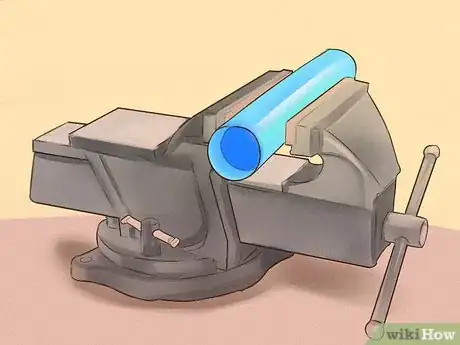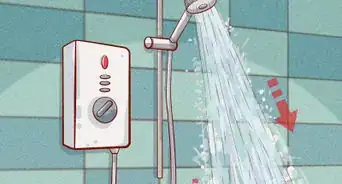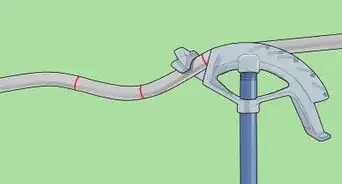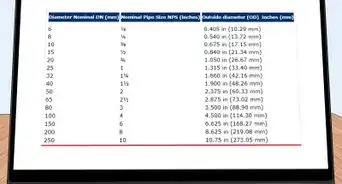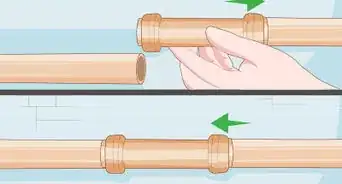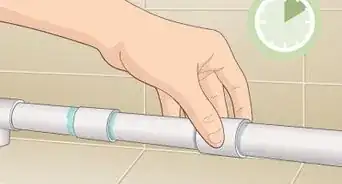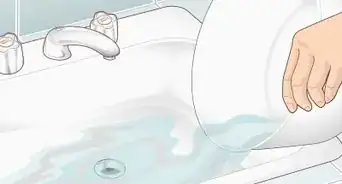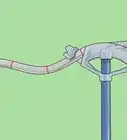This article was co-authored by Patrick Johns. Patrick Johns is a Home Improvement Specialist and the Owner of CatchAll Handyman Services. With more than 28 years of experience, he has worked on a variety of home improvement projects, such as carpentry, plumbing, and door and window installations in both commercial and residential properties.
wikiHow marks an article as reader-approved once it receives enough positive feedback. This article has 11 testimonials from our readers, earning it our reader-approved status.
This article has been viewed 588,259 times.
Making projects out of PVC pipe will often require the pipe to be cut. One of the beneficial things about PVC is that it can be easily cut, with a wide variety of tools, making the job relatively simple. You don't need a complicated set-up or fancy tools to cut PVC. An assortment of different tools including hacksaws, pipe cutters, and a miter saw can be used to get the job done properly.
Steps
Cutting with a Hacksaw
-
1Clamp the pipe into place with a vise. The most basic and most widely used tool in cutting pipe, PVC or otherwise, would be the hacksaw.[1] It's still important to secure the PVC in place using a vise, to avoid letting it slip around and risk cutting yourself with a glancing swipe of the blade. Be extremely careful and take the necessary precautions in clamping the pipe into the place.[2]
- You could also use another type of work clamp to just secure the pipe into place on your workbench, rather than using a vise. Use what's available.
- Clamp it a few inches away from the cut to give yourself ample clearance. If possible, you can clamp on both sides of your cut, but having one clamp a few inches from the intended cut line will make it plenty secure.
-
2Mark your PVC where the cut is required. Use a permanent marker to clearly indicate where on the pipe you're going to cut. Don't worry about whether or not the ink will stay on, you can wipe it off later with some rubbing alcohol if you're feeling cosmetic.Advertisement
-
3Seat the teeth into the pipe. Place the hacksaw onto the mark and hold the handle firmly, then use your other hand to push down on the top of the saw, seating the teeth into the pipe. You want to start in the right place, and doing this will help to ensure that you don't start off with some raggedy swipes of the saw.
-
4Saw through the pipe firmly.[3] Start sawing, keeping sure to watch closely as you cut and don’t let the saw drift from the mark that you made originally. Saw fast enough to keep the cut going, but not so fast the teeth jump over the cut your'e making. You should be able to cut through PVC relatively quickly.
Using a Pipe Cutter
-
1Get a plastic pipe cutter.[4] There are two kinds of PVC pipe cutters: scissor style and ratcheting style. Scissor style pipe cutters are ideal for 1/2” to 1” PVC pipe, but are sometimes too difficult to use even for pipe that big. It's recommended instead that you use a ratcheting plastic pipe cutter, ideal for larger sized pipes and also effective for smaller. It's much safer and more reliable.
- The arm strength necessary to use scissor-style cutters is sometimes a little extreme, and it would be easier to just use a saw of some kind. Investing in a ratchet style cutter will make your job a whole lot easier.
-
2Place the pipe into the half-moon shaped lower part of the cutter. Pipe-cutters have an open rounded edge to seat the pipe into, and a blade that will extend as you squeeze the trigger on the handle. Mark where you want the cut to be made, then seat the pipe in the mouth of the cutter to start cutting.
-
3Ratchet the blade down onto the pipe.[5] Squeeze the hand-grip trigger on the handle of the pipe cutter to extend the blade and cut the pipe in half. Use your other hand to hold the pipe steady as it's cut. You shouldn't have to work very hard.
Cutting with a Miter Saw
-
1Consider using a miter box and saw for more specific cuts. A miter saw can be used for PVC projects that require many specific, detailed cuts. Use a tooth-count saw appropriate to the cutting job and the saws available. When in doubt, go with something like a standard 10 Tooth per-inch (TPI) wood blade, which comes with most miter saws. It'll depend on the particular brand and style of saw that you've got, though.
-
2Place the PVC pipe under the blade where you need your cut. Miter boxes are the easiest things in the world to use, since you've got the cut-lines pre marked alongside the box for you. You won't be able to miss.
-
3Secure the pipe with a work clamp. Start the blade and bring it down at a fairly slow to medium speed. Once cut, the process can be repeated with ease, making additional cuts in the pipe as necessary.[6]
Community Q&A
-
QuestionAny tips on the best way to cut a 90mm PVC pipe longitudinally (to make a shallow drain)?
 Community AnswerI would try a table saw with the fence distance set to half the exterior diameter of the PVC tube. just made sure the blade is tall enough or you will only cut one side.
Community AnswerI would try a table saw with the fence distance set to half the exterior diameter of the PVC tube. just made sure the blade is tall enough or you will only cut one side. -
QuestionHow should I bust a wall to repair a leaking pipe?
 Community AnswerIf it's drywall, an electric sabre saw can be used. Cut along the 2x4s since you don't want the wall to fall down, and just cut the opening big enough to see what's going on. If the inside of the drywall is contaminated, just cut out the largest piece that is affected. Then, measure a replacement, put in the patch, and use silicon caulk and nails to attach the new piece to the 2/4s. You'll need to paint the wall when you're finished.
Community AnswerIf it's drywall, an electric sabre saw can be used. Cut along the 2x4s since you don't want the wall to fall down, and just cut the opening big enough to see what's going on. If the inside of the drywall is contaminated, just cut out the largest piece that is affected. Then, measure a replacement, put in the patch, and use silicon caulk and nails to attach the new piece to the 2/4s. You'll need to paint the wall when you're finished. -
QuestionDo I have to wear a mask?
 Community AnswerNo, you don't need a mask, although one is advised to protect your lungs and throat from any airborne particles that could be harmful.
Community AnswerNo, you don't need a mask, although one is advised to protect your lungs and throat from any airborne particles that could be harmful.
Warnings
- Always use eye protection when cutting PVC pipe. If the pipe is old and brittle, it could crack and pieces of pipe could be dislodged and sent through the air.⧼thumbs_response⧽
Things You'll Need
- PVC Pipe
- Hacksaw
- PVC Cutter or Plastic Pipe Cutter
- Miter Saw
References
- ↑ Patrick Johns. Home Improvement Specialist. Expert Interview. 26 October 2021.
- ↑ https://makezine.com/projects/skill-builder-pvc-pipe/
- ↑ Patrick Johns. Home Improvement Specialist. Expert Interview. 26 October 2021.
- ↑ Patrick Johns. Home Improvement Specialist. Expert Interview. 26 October 2021.
- ↑ Patrick Johns. Home Improvement Specialist. Expert Interview. 26 October 2021.
- ↑ https://formufit.com/pages/how-to-cut-pvc-pipe#miter
- ↑ Patrick Johns. Home Improvement Specialist. Expert Interview. 26 October 2021.
- https://www.youtube.com/watch?v=_JNqn4iSq9s
About This Article
To cut PVC pipe, start by clamping it down with a vise so it doesn't slip when you're cutting it. Then, mark where you want to cut the pipe with a permanent marker. Next, grab a hacksaw and place the teeth of the saw on the line you marked. When you're ready, saw back and forth with the hacksaw until you've cut through the pipe. If you don't have a hacksaw, you can also use a miter saw. If you want to learn more, like how to use a pipe cutter on PVC, keep reading the article!
